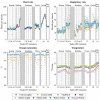Continuous Monitoring of Vital Signs With Wearable Sensors During Daily Life Activities: Validation Study
- PMID: 34994703
- PMCID: PMC8783291
- DOI: 10.2196/30863
Continuous Monitoring of Vital Signs With Wearable Sensors During Daily Life Activities: Validation Study
Abstract
Background: Continuous telemonitoring of vital signs in a clinical or home setting may lead to improved knowledge of patients' baseline vital signs and earlier detection of patient deterioration, and it may also facilitate the migration of care toward home. Little is known about the performance of available wearable sensors, especially during daily life activities, although accurate technology is critical for clinical decision-making.
Objective: The aim of this study is to assess the data availability, accuracy, and concurrent validity of vital sign data measured with wearable sensors in volunteers during various daily life activities in a simulated free-living environment.
Methods: Volunteers were equipped with 4 wearable sensors (Everion placed on the left and right arms, VitalPatch, and Fitbit Charge 3) and 2 reference devices (Oxycon Mobile and iButton) to obtain continuous measurements of heart rate (HR), respiratory rate (RR), oxygen saturation (SpO2), and temperature. Participants performed standardized activities, including resting, walking, metronome breathing, chores, stationary cycling, and recovery afterward. Data availability was measured as the percentage of missing data. Accuracy was evaluated by the median absolute percentage error (MAPE) and concurrent validity using the Bland-Altman plot with mean difference and 95% limits of agreement (LoA).
Results: A total of 20 volunteers (median age 64 years, range 20-74 years) were included. Data availability was high for all vital signs measured by VitalPatch and for HR and temperature measured by Everion. Data availability for HR was the lowest for Fitbit (4807/13,680, 35.14% missing data points). For SpO2 measured by Everion, median percentages of missing data of up to 100% were noted. The overall accuracy of HR was high for all wearable sensors, except during walking. For RR, an overall MAPE of 8.6% was noted for VitalPatch and that of 18.9% for Everion, with a higher MAPE noted during physical activity (up to 27.1%) for both sensors. The accuracy of temperature was high for VitalPatch (MAPE up to 1.7%), and it decreased for Everion (MAPE from 6.3% to 9%). Bland-Altman analyses showed small mean differences of VitalPatch for HR (0.1 beats/min [bpm]), RR (-0.1 breaths/min), and temperature (0.5 °C). Everion and Fitbit underestimated HR up to 5.3 (LoA of -39.0 to 28.3) bpm and 11.4 (LoA of -53.8 to 30.9) bpm, respectively. Everion had a small mean difference with large LoA (-10.8 to 10.4 breaths/min) for RR, underestimated SpO2 (>1%), and overestimated temperature up to 2.9 °C.
Conclusions: Data availability, accuracy, and concurrent validity of the studied wearable sensors varied and differed according to activity. In this study, the accuracy of all sensors decreased with physical activity. Of the tested sensors, VitalPatch was found to be the most accurate and valid for vital signs monitoring.
Keywords: accuracy; biosensor; continuous monitoring; mHealth; telemonitoring; validity; vital signs; wearable; wearable sensors.
©Marjolein E Haveman, Mathilde C van Rossum, Roswita M E Vaseur, Claire van der Riet, Richte C L Schuurmann, Hermie J Hermens, Jean-Paul P M de Vries, Monique Tabak. Originally published in JMIR Formative Research (https://formative.jmir.org), 07.01.2022.
Conflict of interest statement
Conflicts of Interest: None declared.
Figures





Similar articles
-
Continuous monitoring of vital signs with the Everion biosensor on the surgical ward: a clinical validation study.Expert Rev Med Devices. 2021 Dec;18(sup1):145-152. doi: 10.1080/17434440.2021.2019014. Epub 2021 Dec 27. Expert Rev Med Devices. 2021. PMID: 34937478
-
Validity and Reliability of Wearable Sensors for Continuous Postoperative Vital Signs Monitoring in Patients Recovering from Trauma Surgery.Sensors (Basel). 2024 Oct 1;24(19):6379. doi: 10.3390/s24196379. Sensors (Basel). 2024. PMID: 39409419 Free PMC article.
-
A Chest Patch for Continuous Vital Sign Monitoring: Clinical Validation Study During Movement and Controlled Hypoxia.J Med Internet Res. 2021 Sep 15;23(9):e27547. doi: 10.2196/27547. J Med Internet Res. 2021. PMID: 34524087 Free PMC article.
-
Apple watch accuracy in monitoring health metrics: a systematic review and meta-analysis.Physiol Meas. 2025 Apr 17;46(4). doi: 10.1088/1361-6579/adca82. Physiol Meas. 2025. PMID: 40199339
-
Current Evidence for Continuous Vital Signs Monitoring by Wearable Wireless Devices in Hospitalized Adults: Systematic Review.J Med Internet Res. 2020 Jun 17;22(6):e18636. doi: 10.2196/18636. J Med Internet Res. 2020. PMID: 32469323 Free PMC article.
Cited by
-
The Related Metabolic Diseases and Treatments of Obesity.Healthcare (Basel). 2022 Aug 25;10(9):1616. doi: 10.3390/healthcare10091616. Healthcare (Basel). 2022. PMID: 36141228 Free PMC article. Review.
-
Early Warning Scores to Support Continuous Wireless Vital Sign Monitoring for Complication Prediction in Patients on Surgical Wards: Retrospective Observational Study.JMIR Perioper Med. 2023 Aug 30;6:e44483. doi: 10.2196/44483. JMIR Perioper Med. 2023. PMID: 37647104 Free PMC article.
-
Initiatives to detect and prevent death from perioperative deterioration.Curr Opin Anaesthesiol. 2023 Dec 1;36(6):676-682. doi: 10.1097/ACO.0000000000001312. Epub 2023 Sep 28. Curr Opin Anaesthesiol. 2023. PMID: 37767926 Free PMC article. Review.
-
Remote monitoring technologies for measuring cardiovascular functions in community-dwelling adults: a systematic review.Geroscience. 2023 Oct;45(5):2939-2950. doi: 10.1007/s11357-023-00815-4. Epub 2023 May 18. Geroscience. 2023. PMID: 37204639 Free PMC article.
-
Reliable Contactless Monitoring of Heart Rate, Breathing Rate, and Breathing Disturbance During Sleep in Aging: Digital Health Technology Evaluation Study.JMIR Mhealth Uhealth. 2024 Aug 27;12:e53643. doi: 10.2196/53643. JMIR Mhealth Uhealth. 2024. PMID: 39190477 Free PMC article.
References
-
- Kruse CS, Soma M, Pulluri D, Nemali NT, Brooks M. The effectiveness of telemedicine in the management of chronic heart disease - a systematic review. JRSM Open. 2017 Mar;8(3):1–7. doi: 10.1177/2054270416681747. http://europepmc.org/abstract/MED/28321319 10.1177_2054270416681747 - DOI - PMC - PubMed
-
- Inglis SC, Clark RA, McAlister FA, Stewart S, Cleland JG. Which components of heart failure programmes are effective? A systematic review and meta-analysis of the outcomes of structured telephone support or telemonitoring as the primary component of chronic heart failure management in 8323 patients: abridged Cochrane review. Eur J Heart Fail. 2011 Sep;13(9):1028–40. doi: 10.1093/eurjhf/hfr039.hfr039 - DOI - PubMed
LinkOut - more resources
Full Text Sources

